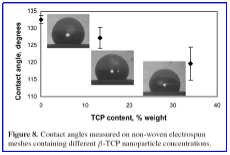FUNCTIONALLY GRADED MATERIALSDesign and processing of devices that could be used in tissue engineering is a challenge because the tissues possess complex structures with gradients in properties and functions (Fig-1). Since an abrupt change in material properties between two homogeneous materials generally leads to mechanical failure due to high stress concentrations accumulated at the interface, fabrication of devices with gradients in properties, i.e. functionally graded materials, is a requirement for the mimicking of structures of native tissues.
|
|
Fig-2. An example of creating functional grading: Continuously graded beta-tricalcium phosphate nanoparticles in nanofibrous mesh of polycaprolactone (A), and the functional effect of such grading on tensile (B) and surface (C) properties (Source: Erisken et al. Biomaterials, 2008) |



|
A |
|
B |
|
C |
|
To be able to design and process suitable biomaterials, I am, firstly, interested in fabricating functionally graded biomaterials (Fig-2 depicts an example of grading created in a nanofibrous mesh, and the resulting functionality in terms of mechanical properties and surface wettability).
Research up to date has demonstrated that controlling the cell behavior is very critical in the engineering of tissues and that cells interact with biomaterials following the principle of “contact guidance”. For example, nanoscale topographies were shown to induce differentiation of stem cells into different lineages. Therefore, design and fabrication of nanostructured devices could be very attractive for administering the cell behavior. In this regard, carrying out research in the processing of nanocomposites such as nanoparticle incorporated nanofibers is the topic of my interest.
|

|
Fig-1. Gradient at anterior cruciate ligament-to-bone interface: Variation in structure and composition with distance. |

|
Cevat Erisken, Ph.D. |
|
TOBB University of Economics and Technology, Biomedical Engineering Department |
|
TOBB University of Economics and Technology |


